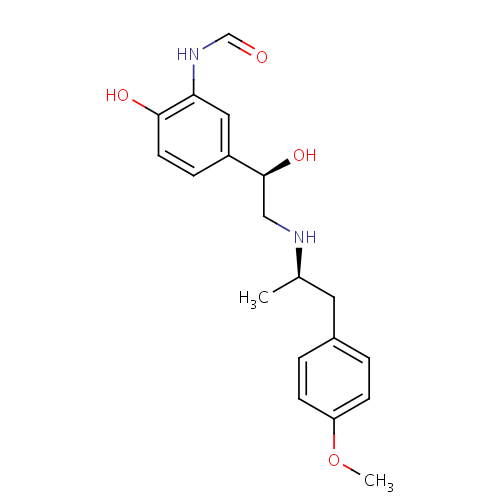| Indication | A bronchodilator used for the long term, symptomatic treatment of reversible bronchoconstriction in patients with chronic obstructive pulmonary disease (COPD), including chronic bronchitis and emphysema. |
| Pharmacodynamics | Arformoterol, the active (R,R)-enantiomer of formoterol, is a selective long-acting β2-adrenergic receptor agonist (beta2-agonist) that has two-fold greater potency than racemic formoterol (which contains both the (S,S) and (R,R)-enantiomers). The (S,S)-enantiomer is about 1,000-fold less potent as a β2-agonist than the (R,R)-enantiomer. Arformoterol seems to have little or no effect on β1-adrenergic receptors. |
| Mechanism of action | While it is recognized that β2-receptors are the predominant adrenergic receptors in bronchial smooth muscle and β1-receptors are the predominant receptors in the heart, data indicate that there are also β2-receptors in the human heart comprising 10% to 50% of the total beta-adrenergic receptors. The precise function of these receptors has not been established, but they raise the possibility that even highly selective β2-agonists may have cardiac effects. The pharmacologic effects of β2-adrenoceptor agonist drugs, including arformoterol, are at least in part attributable to stimulation of intracellular adenyl cyclase, the enzyme that catalyzes the conversion of adenosine triphosphate (ATP) to cyclic-3′,5′-adenosine monophosphate (cyclic AMP). Increased intracellular cyclic AMP levels cause relaxation of bronchial smooth muscle and inhibition of release of proinflammatory mediators from cells, especially from mast cells. In vitro tests show that arformoterol is an inhibitor of the release of mast cell mediators, such as histamine and leukotrienes, from the human lung. Arformoterol also inhibits histamine-induced plasma albumin extravasation in anesthetized guinea pigs and inhibits allergen-induced eosinophil influx in dogs with airway hyper-response. |
| Absorption | Not Available |
| Volume of distribution | Not Available |
| Protein binding | The binding of arformoterol to human plasma proteins in vitro was 52-65% at concentrations of 0.25, 0.5 and 1.0 ng/mL of radiolabeled arformoterol. |
| Metabolism | Arformoterol was almost entirely metabolized following oral administration of 35 mcg of radiolabeled arformoterol in eight healthy subjects. Direct conjugation of arformoterol with glucuronic acid was the major metabolic pathway. O-Desmethylation is a secondary route catalyzed by the CYP enzymes CYP2D6 and CYP2C19. |
| Route of elimination | After administration of a single oral dose of radiolabeled arformoterol to eight healthy male subjects, 63% of the total radioactive dose was recovered in urine and 11% in feces within 48 hours. Direct glucuronidation of arformoterol is mediated by several UGT enzymes and is the primary elimination route. |
| Half life | In COPD patients given 15 mcg inhaled arformoterol twice a day for 14 days, the mean terminal half-life of arformoterol was 26 hours. |
| Clearance |
|
| Toxicity | A death was reported in dogs after a single oral dose of 5 mg/kg (approximately 4500 times the maximum recommended daily inhalation dose in adults on a mg/m2 basis). As with all inhaled sympathomimetic medications, cardiac arrest and even death may be associated with an overdose. |
Saturday, October 13, 2012
Pharmacology Of Arformoterol
Labels:
Pharmacology of Drugs,
UNCLASSIFIED
Subscribe to:
Post Comments (Atom)

No comments:
Post a Comment